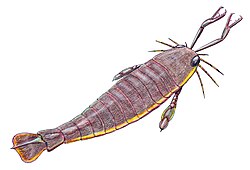
This timeline of eurypterid research is a chronologically ordered list of important fossil discoveries, controversies of interpretation, and taxonomic revisions of eurypterids, a group of extinct aquatic arthropods closely related to modern arachnids and horseshoe crabs that lived during the Paleozoic Era.
Contents
- 19th century
- 1810s
- 1820s
- 1830s
- 1840s
- 1850s
- 1860s
- 1870s
- 1880s
- 1890s
- 20th century
- 1900s
- 1910s
- 1920s
- 1930s
- 1940s
- 1950s
- 1960s
- 1970s
- 1980s
- 1990s
- 21st century
- 2000s
- 2010s
- 2020s
- See also
- References
- External links
The scientific study of eurypterids began in the early 19th century when James E. DeKay recognized a fossil that had previously been described as that of a fish as arthropod in nature. Though DeKay erroneously believed the fossil to represent a crustacean and a missing link between trilobites and branchiopods, the fossil became the type species of first ever eurypterid to be scientifically described, Eurypterus remipes , in 1825. [1]
Over 250 species of eurypterids in 74 recognized valid genera have been described since the discovery of Eurypterus remipes. [2] The most recent genus to be described is Terropterus (2021) and the most recent species is its type species Terropterus xiushanensis (2021). [3]



















